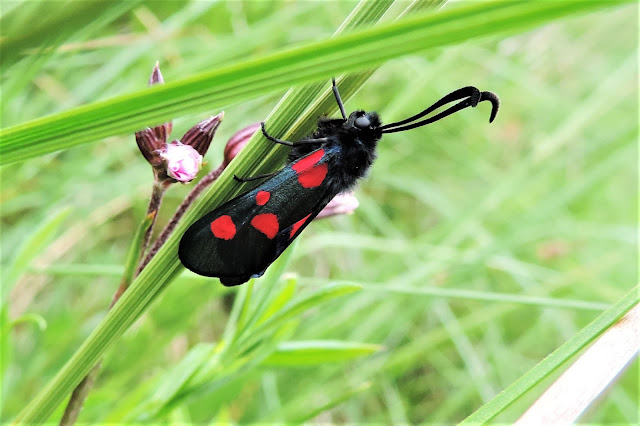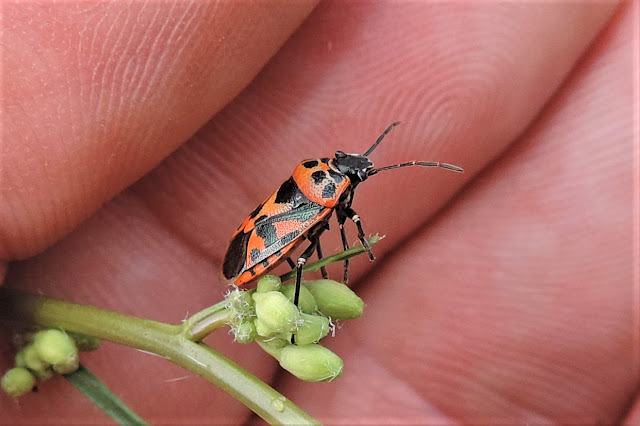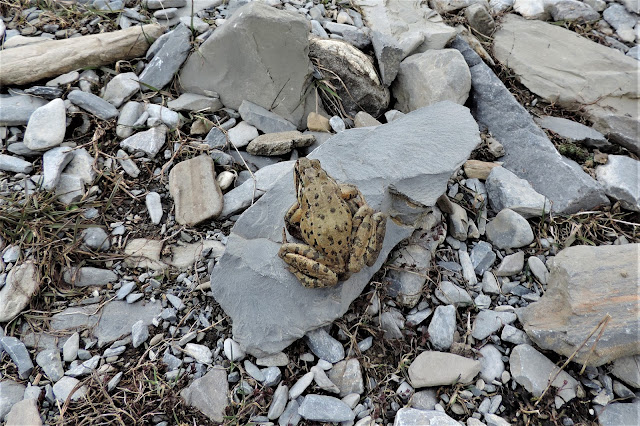The umbellifer "Hemlock Water Droplet" is on its last legs in the woods but still managed to record 24 species of hoverflies. Highlights being first of year for Leucozona glaucia and Platycheirus scutatus agg. I potted an Orthonevra species which was certainly new for the valley, but when I got home the pot top had come loose in my pocket and the fly had legged it 😧. Lots of other insects were about today including the tachinid flies Phasia hemiptera and Dexiosoma caninum, The Noon Fly "Mesembrina meridiana" with its bright orange patches at the base of wings. Other highlights included Tree Bumblebee, Gwynne's-mining Bee, longhorn beetles Rutpela maculata and Grammoptera ruficornis. On The moth front I had an Ypsolopha parenthesella without the white mark on the wing and of course those pesky Notch-horned Clegg - 3 bites today. Even though they give a nasty bite I still like looking at them in case it is one of the rarer species . Ground and plant bugs are starting to reach their last full adult instar and it will soon be time to start photographing them for ID purposes - Had Grypocoris stysi adult today as the first of the year. Finally the soldier beetle Rhagonycha fulva was present on the two Hogweed plants that have started to flower.
Cheilosia impressa
Tachinidae fly - Dexiosoma caninum
Noon Fly Mesembrina meridiana not following British Summer Time at 1300hrs.
Tachinidae fly - Phasia hemiptera
soldier beetle - Rhagonycha fulva
Rutpela maculata
Ypsolopha parenthsella
Tuesday, 27 June 2017
Monday, 26 June 2017
Garnwen butterflies
Hoverflies were poor today only 14 common species, won't be to long before the Hogweed bumps up the numbers though. The highlight though was a largish emergence of Ringlet butterfly. I counted 35 individuals within a quarter of a mile circuit. Meadow Browns are also emerging but at lower numbers and I counted 11 on the same circuit. Both species spent most of the time fighting each-other for dominance of the woodland rides. Even though there were less Meadow Brown they seemed to be winning.
I have a few plants and such to put on Ispot, but its down for a rebuilt for a few days. So I'll post separately if anything interesting comes from the photos.
Ringlet
Meadow Brown
Notch-horned Cleg - sucking the blood out of me, 5 attacks today.
I have a few plants and such to put on Ispot, but its down for a rebuilt for a few days. So I'll post separately if anything interesting comes from the photos.
Ringlet
Meadow Brown
Notch-horned Cleg - sucking the blood out of me, 5 attacks today.
Thursday, 22 June 2017
Darren Woods 21/06/17
Hopefully this is the last day with temperatures above 30c, a sharp drop back to 20c will bring back out most of the insect families. Today in the dappled sunlight of the woods 14 species of hoverfly were seen with Leucozona laternaria being the best, also potted a Platycheirus that keys out to occultus [which would be new for valley], but I'll have to wait until the end of year for confirmation, when I send the specimens I've gathered to HRS. Due to the lack of flies other families and species become more prevalent and I spotted an unusual harvestman in Dicranopalpus ramosos which is new for me and probably the valley too. Meadow Browns are starting to emerge with half a dozen seen today.
Dicranopalpus ramosos - identified by the combination of forked pedipalpus and resting posture with legs stretched to the sides.
Leucozona laternaria
Chrysogaster solstitialis - should become very common over the coming weeks
Dicranopalpus ramosos - identified by the combination of forked pedipalpus and resting posture with legs stretched to the sides.
Leucozona laternaria
Chrysogaster solstitialis - should become very common over the coming weeks
Sunday, 18 June 2017
Garnwen
30c meant it was too hot for hoverflies with only 10 species seen, all common. Managed to photograph Large Skipper at last, other butterflies were Speckled Wood, Common Blue, Red Admiral, Small Heath and a single Ringlet. More Odonata were out today in Large Red Damselfly, Azure Damselfly, Emperor Dragonfly and Broad-bodied Chaser. Only moth of note was a Blood-vein, while the bees were all the usual suspects. Another Pachytodes cerambicyformis Longhorn beetle rounded off a quiet time. Photographed another Orchid, which looks different to the other one in an earlier post.
Large Skipper
Orchid species - ??? - I've put it on Ispot
ISPOT - ID'd as Dactylorhiza majalis (traunsteineriodes) sub species Francis-Drucei. English name Western Marsh Orchid. That'll be new for me.
Large Skipper
Orchid species - ??? - I've put it on Ispot
ISPOT - ID'd as Dactylorhiza majalis (traunsteineriodes) sub species Francis-Drucei. English name Western Marsh Orchid. That'll be new for me.
Lletty Brongu Woods
24c is about the limit for hoverflies, so went down the woods along the river in the shade and recorded 24 species with the highlights being Dasysyrphus pinastri [1st of year], Platycheirus ambiguus and Xylota sylvarum. Otherwise Stictoleptura maculata longhorn beetle was new for the year and Gwynne's-mining Bee was plentiful. The first unwelcome Notch-horned Cleg's were in full blood sucking mode and Speckled Wood and Large White were the only butterflies. New blooms included Stinking Tutsan, Water Figwort and Lesser Stitchwort.
Gwynne's-mining Bee
Eristalis tenax - watched this fly walk from the stones into the river about 10" dip its abdomen in the water for 5 seconds, then make its way back to land and onto the stones. I can only think that it was laying eggs knowing that the water would drop and the larva would live in the mud. There is no reference to this behaviour in any literature I could find. Or it could be just having a dip 😓.
Dasysyrphus pinastri - very similar to "venustus" but in pinastri the yellow hooked spots on the abdomen do not reach the side margin of the tergites/abdomen.
Chrysogaster solstitialis
Rutpela maculata
Gwynne's-mining Bee
Eristalis tenax - watched this fly walk from the stones into the river about 10" dip its abdomen in the water for 5 seconds, then make its way back to land and onto the stones. I can only think that it was laying eggs knowing that the water would drop and the larva would live in the mud. There is no reference to this behaviour in any literature I could find. Or it could be just having a dip 😓.
Dasysyrphus pinastri - very similar to "venustus" but in pinastri the yellow hooked spots on the abdomen do not reach the side margin of the tergites/abdomen.
Chrysogaster solstitialis
Rutpela maculata
Wednesday, 14 June 2017
Blaencaerau
A fine not to warm day at 20c. Hoverflies were out in force to coincide with the first bramble blooms here. I recorded a very healthy 36 species a few which are being assessed by HRS, so I'll update if anything new is confirmed. Firsts of the year included Scaeva pyrastri. Pipiza austriaca and Eristalis intricaria. Other highlights were Chrysotoxum cautum, Anasimyia contracta, all 7 species of Eristalis possible, Sericomyia lappona.
Other insects included 4 species of butterfly with Large Skipper first for the year, 6 species of Bumblebee, Broad Centurion soldierfly, Longhorn beetle Pachytodes cerambicyformis. The first emergence of Burnet moths. Had 100+ 5-spot Burnet in the central fields and also in the area that I had Narrow-bordered 5-spot Burnet larva there were 4 present which I assume were that species, but you really can't tell the adults apart. Unusually I had Middle-barred Minor feeding on Umbellifers during the day.
Counted 3 pairs of Stonechat and 9 Whitethroats calling on my walk. Also had 20 new blooms for the year, so the rain did have some positive effect.
Anasimyia contracta
5-spot Burnet
Middle-barred Minor
Broad Centurion - this is the commonest fly mis-identified as a hoverfly
Other insects included 4 species of butterfly with Large Skipper first for the year, 6 species of Bumblebee, Broad Centurion soldierfly, Longhorn beetle Pachytodes cerambicyformis. The first emergence of Burnet moths. Had 100+ 5-spot Burnet in the central fields and also in the area that I had Narrow-bordered 5-spot Burnet larva there were 4 present which I assume were that species, but you really can't tell the adults apart. Unusually I had Middle-barred Minor feeding on Umbellifers during the day.
Counted 3 pairs of Stonechat and 9 Whitethroats calling on my walk. Also had 20 new blooms for the year, so the rain did have some positive effect.
Anasimyia contracta
5-spot Burnet
Middle-barred Minor
Broad Centurion - this is the commonest fly mis-identified as a hoverfly
Tuesday, 13 June 2017
Garnwen
First day of fine weather for what seems like an eternity. Insects were out in force with 25 species of hoverfly. A large emergence of Syrphus species was noted with over a 100 of torvus and ribesii. New for the year were Baccha elongata and Didea fasciata. With other good sightings including Melanostoma mellinum, Xanthogramma pedissequum, Sericomyia lappona, Criorhina berberina and Xylota jakutorum. 5 species of butterfly, 7 species of Bumblebee were seen. Willow Tortrix added to the day moths and a Broad-bodied Chaser dragonfly was new for the year. Finally Pachytodes cerambicyformis [longhorn beetle] was on bramble.
Also some first of the year blooms in Bittersweet, Tutsan, Cross-leaved Heath, Cut-leaved Dead-nettle and another type of Orchid.
Didea fasciata
Volucella bombylans
Xylota jakutorum
Pachytodes cerambicyformis
Common-spotted Orchid [per Sid]
Common-spotted Orchid [per Sid]
Also some first of the year blooms in Bittersweet, Tutsan, Cross-leaved Heath, Cut-leaved Dead-nettle and another type of Orchid.
Didea fasciata
Volucella bombylans
Xylota jakutorum
Pachytodes cerambicyformis
Common-spotted Orchid [per Sid]
Common-spotted Orchid [per Sid]
Georgia - scenic shots
Ananuri church - looking like something out of Monty Python and the Holy Grail
Graveyard busts are very popular in Georgia - this one looks like Orlando Bloom
Friendship Monument - just below the Jvari Pass
Top of the Jvari Pass
Kazbegi mountain above Stepantsminda at 1700 feet. In Greek Mythology this is the mountain that Prometheus was chained to by the gods for given mankind the gift of fire. A vulture would eat his liver by day, while it would grow back during the night and then continually repeat the process for everlasting pain. There's benevolent of the them.
Close up view of the Kazbegi peak
Mother Georgia, a 200 foot statue overlooking Tbilisi. Those dots are Swifts
Church of St Elias 7200 foot above Stepantsminda
Kobi - an abandoned village in the Tergi Valley
The Snowcock and Grouse peaks. Viewing area is just at the edge of the forest.
Graveyard busts are very popular in Georgia - this one looks like Orlando Bloom
Friendship Monument - just below the Jvari Pass
Top of the Jvari Pass
Kazbegi mountain above Stepantsminda at 1700 feet. In Greek Mythology this is the mountain that Prometheus was chained to by the gods for given mankind the gift of fire. A vulture would eat his liver by day, while it would grow back during the night and then continually repeat the process for everlasting pain. There's benevolent of the them.
Close up view of the Kazbegi peak
Mother Georgia, a 200 foot statue overlooking Tbilisi. Those dots are Swifts
Church of St Elias 7200 foot above Stepantsminda
Kobi - an abandoned village in the Tergi Valley
The Snowcock and Grouse peaks. Viewing area is just at the edge of the forest.
Georgia - other insects
Mylabris quattuordecimpunctata [blister beetle]
Omophlus lepturoides [ Tenebroid beetle]
Eurydema ornata [Ornate Bug]
Oxythrea cinctella [Chafer Beetle] - English name - Middle-eastern Flower Scarab
Pygopleurus hirsutulus [Chafer Beetle]
Crab Spider species
Omophlus lepturoides [ Tenebroid beetle]
Eurydema ornata [Ornate Bug]
Oxythrea cinctella [Chafer Beetle] - English name - Middle-eastern Flower Scarab
Pygopleurus hirsutulus [Chafer Beetle]
Crab Spider species
Georgia - reptiles and amphibians
Caucasian Agama
Caucasian Green Lizard
Long-legged Wood Frog
Mediterranean Tortoise having fun!
According to locals sheep are too stupid to lead the flocks between pastures, so they use a single goat to lead the flock instead, flocks are usually 300+ strong and they follow the goat everywhere. They can't use Rams as they only have one thing on their minds when they see 300 sheep 😈.
Caucasian Green Lizard
Long-legged Wood Frog
Mediterranean Tortoise having fun!
According to locals sheep are too stupid to lead the flocks between pastures, so they use a single goat to lead the flock instead, flocks are usually 300+ strong and they follow the goat everywhere. They can't use Rams as they only have one thing on their minds when they see 300 sheep 😈.
Subscribe to:
Comments (Atom)




















































